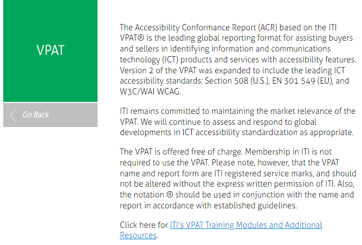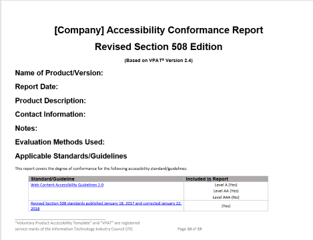This page is intended to instruct users on how to develop an Accessibility Conformance Report (ACR) using a Voluntary Product Accessibility Template (VPAT®). This information was adapted from NASA’s Demystifying Section 508: An Industry Guide to Understanding Section 508 of the Rehabilitation Act. For more information on ACRs and VPATs™ visit the Acquisition section of Section508.gov.
The ACR is a representation of how the product meets the applicable Section 508 Technical Standards. The product owner/developer must first test the product against those standards in order to complete an ACR. Currently, the most common way an ACR is completed is by using the (VPAT® template created by the IT Industry Council (ITI).
Although there are other possible methods to complete an ACR, this part of the guide will walk you through how to complete an ACR using the VPAT®.
Step 1: Download the VPAT®
The VPAT® is a free template that may be downloaded by going to the ITI website. If you are selling to the U.S. federal government, then you must use the Revised Section 508 or the INT International Editions of the template (which include all Revised Section 508 requirements).

Step 2: Complete the Accessibility Conformance Report (ACR) Title Page
- Company name
- Name of your product (and version number, if applicable)
- Report date (month and year)
- Description of the product
- Contact information
- Additional notes (if any)
- Evaluation methods: Information about how your product was tested (manual, automated, both), testing tools used, etc.

Find the page with the heading, “[Company] Accessibility Conformance Report Revised Section 508 Edition”. As noted in the ITI VPAT® training videos, the following information must be provided:
Step 3: Understand the three columns of the VPAT® tables
First column: “Criteria”
The first column of the tables states the criteria to be covered by that particular row.
Second column: “Conformance Level”
The second column of each table is labeled “Conformance Level.” We will cover the nuances between different tables below.
For the category or categories which encompass the product, you must use one of four phrases—supports, partially supports, does not support, not applicable— to describe the level of conformance.
- Supports: The functionality of the product has at least one method that meets the criterion without known defects or meets with equivalent facilitation.
- Partially Supports: Some functionality of the product does not meet the criterion.
- Does Not Support: The majority of product functionality does not meet the criterion.
- Not Applicable: The criterion is not relevant to the product.
Note: The “not evaluated” phrase may only be used for the Level AAA table since this is the only success criteria table that is not required to be completed.
Third column: “Remarks and Explanations”
The third column is reserved for remarks, which are required if the product either partially supports or does not support the guideline. If the product supports a particular guideline, then remarks are encouraged, but not required.
Step 4: Complete Table 1: Success Criteria Level A and Table 2: Success Criteria Level AA, if applicable
If your product fits one or more of the following categories, then the WCAG 2.0 Standards apply to your product:
- Web Content
- Electronic Documents
- Software
- Authoring Tool
If your product does not fall under any of these four categories, you may write “Not Applicable” in the notes section for the Success Criteria tables.
The Success Criteria tables laid out in the VPAT® template—Levels A, AA, and AAA—cover the WCAG success criteria (e.g., page 12 of VPAT® 2.4Rev508).
Only Level A and AA are required in an ACR intended to inform U.S. federal procurement. However, if your product does satisfy some (or all) Level AAA success criteria guidelines, then it is beneficial to complete that table as well, as it would provide additional motivation for federal agencies to purchase your product and attract a wider range of potential customers. Below is an example of what these three columns look like for the WCAG table:
| Crietria | Conformance Level | Remarks and Explanations |
|---|---|---|
|
1.1.1 Non-text Content (Level A) Also applies to: Revised Section 508
|
Web: Electronic Docs: Software: Closed: Authoring Tool: |
Web: Electronic Docs: Software: Closed: Authoring Tool: |
Step 5: Determine the applicability of the Revised Section 508 Technical Standards to your product
There are four Revised Section 508 tables, labeled as Chapter 3 (Functional Performance Criteria), Chapter 4 (Hardware), Chapter 5 (Software), and Chapter 6 (Support Documentation and Services). Complete the applicable tables.
If there are functions in your product not addressed by Chapters 4 or 5, then your product needs to conform to the criteria in Chapter 3: Functional Performance Criteria. Answer the following questions in order to determine which chapters to complete:
- Does your product contain hardware?
- Complete Chapter 4: Hardware.
- Does your product contain non-web software?
- Complete Chapter 5: Software.
- Does your product contain support documentation and services?
- Complete Chapter 6: Support Documentation and Services.
- If your product cannot be evaluated using the current criteria:
- Complete Chapter 3: Functional Performance Criteria.
For each table, there is a section for notes. Use this field to enter comments about overall applicability of the table to your product.
The first column “Criteria” of the Revised Section 508 tables lists the Section 508 Technical Standards. By selecting the links provided in this column, you may access more information about the standards on the U.S. Access Board’s website.
Below is an example of what these three columns look like for the Revised Section 508 table
| Criteria | Conformance Level | Remarks and Explanations |
|---|---|---|
| 402 Closed Functionality | Heading cell - no response required | Heading cell - no response required |
| 402.1 General | Heading cell - no response required | Heading cell - no response required |
| 402.2 Speech-Output Enabled | Heading cell - no response required | Heading cell - no response required |
| 402.2.1 Information Displayed On-Screen | ||
| 402.2.2 Transactional Outputs | ||
| 402.2.3 Speech Delivery Type and Coordination | ||
| 402.2.4 User Control | ||
| 402.2.5 Braille Instructions |
Step 6: Final checklist to make sure your ACR is complete
Reviewed/Updated: August 2024





